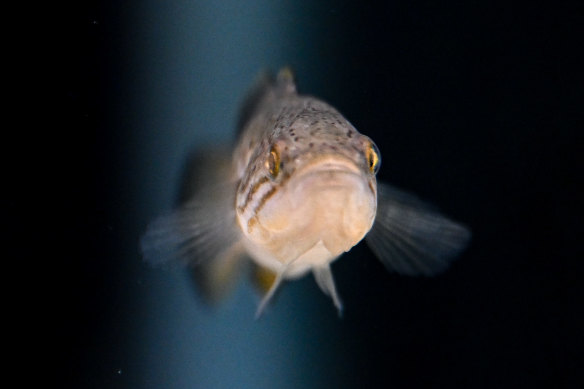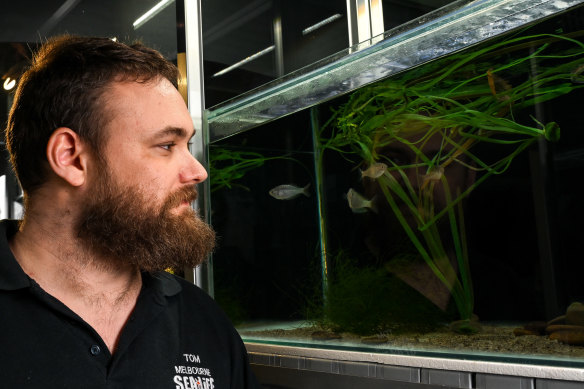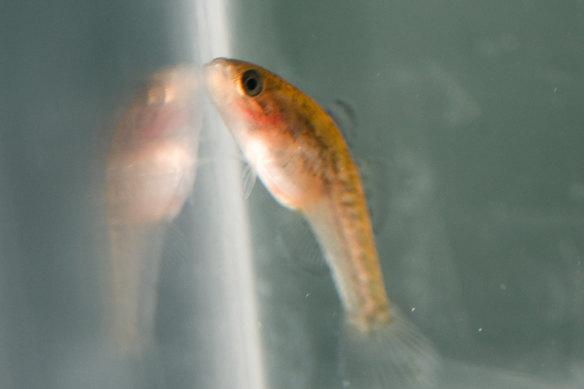‘Risen from the dead’: The head-swelling zombie fish is back after 80 years

It’s the little, quirky fish that refused to stay dead.
Long ago, the unusual Mogurnda adspersa lived in wetlands and billabongs around Victoria, nestled among the riverbottom weeds.
When male came across female, he would show his infatuation by inflating his head to enormous size. And after they mated, he would chase her away so he could delicately care for their eggs himself.
Mogurnda adspersa, photographed at Sea Life Aquarium.Credit: Eddie Jim
But in another regard, adspersa is just like many native Australian animals: pushed to the edge of survival by the way we live.
We destroyed wetlands, muddied creeks and filled them with introduced competitors. Adspersa did not make it. Victorian authorities presumed the fish, also known as the Southern Purple Spotted Gudgeon, went extinct in the 1940s.
But in 2019, scientists chanced across a tiny colony of survivors, huddled in an artificial wetland.
Now, a captive breeding program is set to release its first batch back into the wild. It’s a second chance, for fish and for humans.
Those involved in the rescue have started calling them zombie fish, “because they have risen from the dead,” says Tom Fair, who has been carefully breeding them at Melbourne’s aquarium.
Tom Fair looks at his fish-babies.Credit: Eddie Jim
Adspersa is a small, intelligent fish – no bigger than your hand – with silver flanks dotted in blue.
Fair, an aquarist, has developed a fondness for them. “It’s the classic underdog. I work in an aquarium with sharks and crocodiles. It’s the nuances of a little fish like that you really learn to love.”
Individual gudgeon are quite hardy, but the species as a whole is fragile. It lived in wetlands across the Murray-Darling basin – and wetlands are among the most-threatened environments in Australia.
Farmers have transformed the basin’s rich, fertile land into a breadbasket that provides a third of Australia’s food supply. But the environment has borne the cost.
Water has been sluiced off for irrigation, destroying wetlands; natural flows the fish used for reproduction have been disrupted, and the water that remains is dirty and polluted. Invasive European carp have taken over, eating food and destroying aquatic plants; some parts of the basin are now 90 per cent carp.
Faced with that onslaught, adspersa never stood a chance. A small colony was rediscovered in 1995 near Mildura, but that hope proved short-lived – in just a few years they died out, too.
A baby Mogurnda adspersa.Credit: Eddie Jim
That’s why, when the tiny population was found in 2019 near Kerang, no one took any chances.
Government scientists, working with Sea Life Aquarium and charity partners, have now managed to coax the fish into breeding in tanks.
“It’s trial and error – sometimes it’s not always easy to tell if it’s a male or female, so we pair them off regularly and try to tell if there’s any chemistry,” says Fair.
The first cache of tiny fry emerged from their eggs earlier this year. The plan is to release them back into specially created wetlands cleared of competitors later in the year, to give the fish a chance of recovering in the wild.
“It’s bittersweet – they are no longer under your control and care,” says Fair. “But that’s the whole goal of this program, to get them back into the wild.”
Enjoyed this article? The Examine newsletter explains and analyses science with a rigorous focus on the evidence. Sign up to get it each week.
Most Viewed in National
From our partners
Source: Read Full Article


